Liquid Nitrogen Ice Cream Recipe
A liquid nitrogen ice cream recipe - it uses a vanilla base, and makes a wonderfully creamy ice cream.
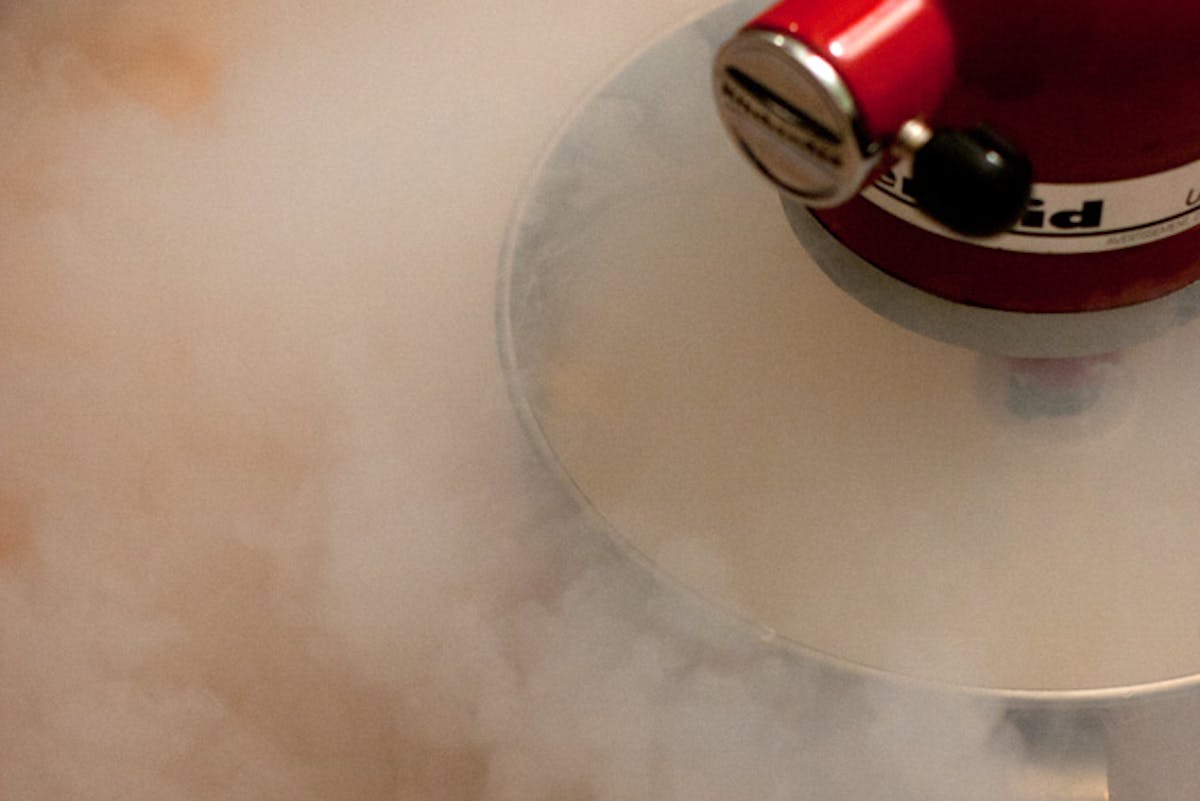
This liquid nitrogen ice cream recipe is a bit of a departure for me - as anyone who reads this site regularly will recognize. I wasn't much of a science geek in college. At the time I was more interested in apertures than atoms, cyanotypes over cryogenics, and vignetting before viscosity. My interest in chemistry pretty much started and stopped in the photography lab. So, it is with a bit of wide-eyed wonderment and curiosity that I observe the molecular gastronomy movement. Watching what is going on is both exciting and intimidating - the laboratory is melding with the kitchen and vice versa. A whole new vocabulary of textures, tastes, and techniques is emerging and evolving.
A friend of a friend showed up at a recent cooking night with a hardcore, four foot tank of liquid nitrogen. What might one do with a giant tank of liquid nitrogen? LN2, for those in the know, btw. Make liquid nitrogen ice cream, of course.
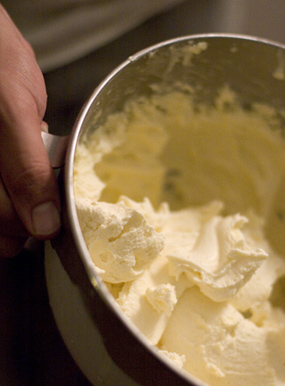
Liquid Nitrogen Ice Cream - creamy!
I needed a play-by-play explanation. Apparently many school-aged kids make liquid nitrogen ice cream as part of elementary-school science lessons. My school however, never made it beyond shaking cream in a jar with a marble to make butter - the year after that we sprouted lima beans.
To make liquid nitrogen ice cream you start with an ice cream base in a metal mixing bowl. Fire up the mixer (Kitchen-Aid was in use here) at low-med speed. Pour the liquid nitrogen into the bowl a bit at a time as the mixer is running. It freezes up ever so creamy and beautifully.
Will I die if I eat it? I asked that. I also asked a host of other questions. Are those plumes of Halloween-looking smoke coming off the bowl going to gobble up all the oxygen in the room? Are we all going to go to sleep and never wake up? You really, really, need to be careful with this stuff - do your homework and really get up to speed on the proper way to handle it (some starter links below). You need to treat it as seriously as you would a deep fryer filled with hot oil and the like. You like your fingers, right? LN2 can cause them to shatter. Imagine what it could go if you got it in your eyes. Survival instincts aside, I savored every bite of the ice cream.
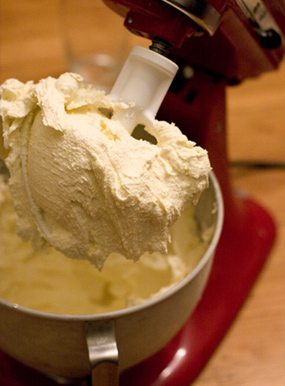
Liquid Nitrogen Ice Cream Recipe
There are lots of chefs playing around with LN2 in the kitchen. If jumping into the molecular gastronomy pond is something that piques your interest, liquid nitrogen ice cream seems like a good gateway recipe. Not sure if I see myself going down to the local welding supply shop to stock up on it, but I understand the allure.
There is an great eGullet thread on cooking with liquid nitrogen. It covers safety considerations, LN2 experiences, and input from people using it in their own kitchens. Also, be sure to read this materials sheet on liquid nitrogen.
One of the things I'm curious about and don't have a good (or well-founded) sense of, is how these "extreme" culinary techniques impact the nutritional or beneficial properties found in food. When I say extreme I mean the extreme fast freeze brought on by liquid nitrogen, or the chefs using lasers - that sort of thing. My sense is that these types of techniques are tough on (natural) ingredients. I have a good sense of what high temps can do to beneficial essential fatty acids (like those found in nuts or unrefined nut oils), or to the phyto-nutrients in fruits and vegetables - and it's not always pretty. I'd love to open this up for discussion.
I'll include the base recipe for my favorite vanilla bean gelato below, I suspect it would pair quite nicely with a tank of the cold stuff. Let me know.
Need more? Here are some links:
Material Safety Data Sheet for Liquid Nitrogen
- Mark Powell's Food Hacking site is. the. best. Super inspired and inspirational.
Keep an eye on Miss Louisa Chu, she is always posting great first-hand accounts from the food science front. Have fun poking around her archives.
- Molecular Gastronomy Resource List courtesy of A La Cuisine.
- Molecular Gastronomy through the Wikipedia lens
- For the cook that really has everything - the anti-griddle
Liquid Nitrogen Ice Cream Recipe
heidi notes: This is a nice, creamy gelato-type base. Infuse it, add stuff, get creative. I wrote this recipe a few years back - I tend to use arrowroot instead of cornstarch as a thickener in recipes that need it (it is usually less-processed than cornstarch). But because I haven't tested arrowroot in this base, I'll give you the cornstarch version. If you use this as a base for liquid nitrogen ice cream, please read up on the safety precautions that must be observed when handling LN2.
4 cups whole organic milk
1 vanilla bean, split
1 cup sugar
3 tablespoons plus 2 teaspoons cornstarch
1 teaspoon vanilla extract
Place three cups of the milk in a saucepan with the vanilla bean over medium-low heat.
Meanwhile, pour the remaining 1 cup milk into a large glass measuring cup. Add the sugar and the cornstarch. Mix well.
When the milk starts to simmer, remove it from the heat and pour in the cornstarch mixture, stirring the whole time. Return the saucepan to medium-low and stir, stir, stir, until things start thickening up, 10 to 12 minutes. It should end up thicker than, say, a runny milkshake, but thinner than a frosty one.
Pour the mixture through a strainer into a mixing bowl, whisk in the vanilla extract, and let it cool on the counter for 20 minutes or so. I like to then chill it in the refrigerator for a few hours or overnight until it is completely chilled.
Now you are ready to place this mixture in a metal-bowl mixer and do the liquid nitrogen thing (see above links and do your safety reading and research first), or you can just freeze this using the manufacturer's instructions on a standard ice-cream maker.
Serves 6.
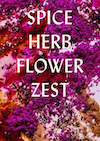
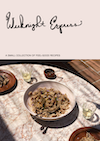

Comments are closed.
Apologies, comments are closed.
Comments
were can i buy in los angeles nitrogen gas?
please help me
mike
Excuse me to slightly drag off the topic, is it feasible to try blast freezing french fries in liquid nitrogen for my 500kg per day small scale business?
I’ve done this ice cream demo in my chemistry classes (high school) for the past few years. It works great, and much better than the ‘baggie in a baggie’ method. 🙂 By the way, for you adventurers out there, try putting some marshmallows or popcorn into the LN2 for a bit, then pop them into your mouth to be able to breathe smoke… I saw the marshmallows on Bill Nye and there is a very upscale restaurant in Chicago (I think) that is serving up popcorn soup like this now… crazy fun!
If you are stirring by hand you can use a wooden spoon (make sure that it’s sturdy). It won’t expand or conduct the cold. Or (as they did in my lab) you can use a metal sppon with a plastic or rubber handle.
We once made a fat carving of a dragon. (For a centre piece for a buffet) Then Poured the liquid nitrogen down the mouth into a hollowed belly area. Then added a few drips of water to give the effect of smoke coming from the mouth. This apparently works well with Ice carvings too. I loved the effect, but I’m glad I didn’t have to handle the LN!
Re: LN2 and pink color
Explained somewhat in article:
http://www.cwi.nl/projects/icpig05/cd/D:/pdf/01-223.pdf
I’m not a physicist, so I had difficulty understanding it, but it seems it relates to N2 resonance at different temperatures & states of excitation. The pink color decreases in warmer environments (eg room temp).
you are AWESOME! By the way, ran into bruce and he gave me a copy of the edible SF. Your pix look awesome!
Can anyone tell me what flavor Circus Peanuts are supposed to be, anyway? I think maybe they are sugar flavored. (and for those that might not know, we are talking about those waffle-textured, orange, peanut-in-the-shell shaped, slightly-spongy-if-you’re-lucky candies that are ubiquitous in corner drugstore candy sections)
where would u buy liquid nitrogen?
i think this would be an awesome recipe to try out.
Wow, I was just telling my sister in law about how to make ice cream using two ziplock baggies, and she was thinking how cool that was.
Lasers on food–that never occurred to me before either. I did read once about edible, printed food at a gourmet restaurant in Chicago, but this is really neat and sounds fun.
But anyway, nitrogeous don´t have a powerful flavor or odor, so make icecream with water, or making whit n2 liquid don´t have to be so different.
You know what? I think that that was an amazing article and I think Heidi did a great job let’s give her a round of applause!!! Sorry…
Seems rather interesting albeit a bit unorthodox (which is the point, I suppose) but I’ll stick with the slow old fashioned way personally. I like the slow process.
I read the pdf from AirProducts Safetygram-7.
Surprised to see icecream histories with N2.
I’d rather stick with the ice cream we have today. Liquid nitrogen involves a little too much risk just to make ice cream. Although it sound really delicious, I just don’t think it’s worth my finger.
whats more fun is LN2 in a modified super soaker! hahaha trees will be frozen forever in my neighborhood now!
How do I get an invite to the ice cream party? Seriously, that sounds like a blast.
-h
Awesome. Thanks for sharing. As to how you came up with this insane recipe (seltzer and lemon juice?) – that should be a secret you never divulge.
In response to Wayne’s request for the Circus Peanut Sorbet recipe:
1) Chop 45 circus peanuts finely.
2) Add one cup of water.
3) Mash with a potato masher. A lot. For a long time. Have a friend around to keep you company.
4) Store glop in refrigerator for 24 hours to let remaining chunks soften.
5) Put glop through blender on a high setting.
6) Add two cups seltzer and about three teaspoons lemon juice.
7) Freeze.
I might also add that this recipe (like many others) seems to work far better with liquid nitrogen. We tried it in an ice
cream maker, and after 45 minutes it was still 100% liquid. It took a good eight hours in the freezer, with occasional stirring,
to reach the consistency of sorbet, and it was still clearly inferior to the rich creamy texture we achieved at JB’s party with LN2.
I presume that the failure to freeze in the ice cream maker is related to the fact that circus peanuts are approximately 84,000% sugar, but perhaps someone more knowledgeable will have greater insight.
WOW that’s… umm… different!
A really fun, inexpensive, rewarding and addicting chemistry project – and safer than handling LN2 – involves barley, yeast, and coned-shaped flowers of Humulus lupulus.
JB you are clearly the ice cream man. One of the recipes you mentioned that caught my interest is “Circus Peanut Sorbet” – care to give us a run down of how that works? Or if it was good?
My physics professors always made this stuff as the grand finale of their demonstrations. It was a lot of fun, and tasty! 🙂
LN2 is not that expensive; rather cheap actually. The most expensive part is the packaging. It’s usually ~$2/gal in individual dewars and ~$0.50/gal when delivered to a bulk storage unit.
It is readily available from the same industrial gas suppliers who sell welding gases (oxygen, acetylene and argon); and frequently available from companies which sell compressed carbon dioxide that is used for soda fountains.
Sounds really cool… and something to be done once…
I wonder what the energy costs are of liquidfying the nitrogen… sounds expensive from an energy (not monetary) perspective.
I’ve been throwing a weekend-long party centered around making ice cream for the past 17 years. About 10-12 years ago – shortly after the 1st write-up of LN2IC showed up in (Scientific American? Popular Science?), we started testing LN2 ice cream.
Within 3 years, we’d completely stopped using our vast array of hand-crank churns and moved exclusively to LN2.
Why’d we start? Because we’re geeks. Why’d we continue? Because: A) how else are you going to produce 83 different flavors of Ice Cream in one weekend? We’re talking 5 minutes a batch. B) no other method so easily allows one to make a 1 cup, or smaller, test batch to see what you’re coming up with. C) The environmental impact of 200L of LN2 released in to the atmosphere is pretty much null, while the disposal of gallons of salt-water in to the woods has quite an impact. D) The extreme cold of LN2 freezing allows an alcohol level in your mixes that you could NEVER get to freeze with normal methods. (Lagavulin Espresso, Drambuie, Midori Sherbet, MacKeson’s XXX… and more. I could swear we did a vodka ice one year, but can’t find it on the list.) E) The texture is, in most cases 80-90% as good as slower churn methods (though with the level of experimentation we get in to (Chicken Liver with Fried Onion, Circus Peanut Sorbet), it’s doubtful that most of them would come out really fabulous anyway. (Though I must say that my Tom Kha (Coconut/Galangal/Lemongrass, based on a cooked-custard recipe) was AMAZINGLY good.)
I must, however, disagree with your comment “And as most ice cream aficionados will tell you, immediacy is a key ingredient when striving for a phenomenal ice cream experience.” – In our experience, most ice-creams (assuming they’re properly formulated to not freeze in to a solid block) are FAR better after they’ve been left to set in a freezer for a couple of hours.
As for safety: While we try to keep people from playing with it too much (as much because we don’t want to waste any in case we need it), people have drunk a bit, it’s been poured over people’s bodies, and otherwise ‘mishandled’ and we’ve never had a bad outcome. The extreme temperatures at work mean that – as long as you don’t actually get the body part in question frozen, the LN2 will boil and create an insulative layer of (gaseous) N2 between it and whatever.
THAT said, don’t be stupid. 🙂
i remember making butter from cream when i was younger! but i don’t remember the marble. I remember the butter being so delicious… and i would love to make it again. do you remember exactly how it was done?!
Very interesting and cool!
What a new way to use liquid nitrogen! I knew that people who work on racecars use it, and my cousin got a wart frozen off with it. Now ice cream too?!?
Very cook trick, Heidi.
Uh yeah, this is pretty cool!! And even without mixer! Awesome and fun!!! I want ice cream!!!
How much does the LN cost? I live down the street from UC Davis, is that where I should go try to get it?
Ooooh heidi, It’s very funnn……..
As a former Chem major, I think this stuf is just freakin’ weird. What, aside from shock value is it for? Is the risk worth the, in this case, speed? So, I was one of those people who expected every bunsen burner to explode when I got a flame near it. But still, why?
I tried your gelato base, and I think there was too much corn starch. It seemed artificially gummy. 🙁 Then again, I don’t have an ice cream maker. So I froze the base in ice cube trays, broke them up, and put them in a food processor.
Thing is, you actually can safely dip your finger into liquid nitrogen so long as you do it slowly and gracefully. The idea is that you end up with a pocket of air around your finger that protects it from freezing. When we made liquid nitrogen ice cream in January, we played around with that, and I was astonished about how my finger did not immediately snap off and shatter.
Looks like fun, I have the advantage of being a chemist so I can get the N2 and know how dangerous it is! This is so going to be made in the next couple of weeks!!
Im still interested though 😀
Three cheers for science geeks!
Laser can destory the nutriive content but it is insignificant because of how they use the lasers. Fast frezzing is okay unless it is too fast in which case the cells walls will be destroyed. due to the interior being frozen as well. This depends also depends upon how cold you frezee it and how long. Think about how liquid nitrogen frezees living cells. If the fast frezzing is accompanied by fast thawing it can due major cell damage. If thawing ocurres at a slower rate there is less damage. You can preserve cell tissuses but the extreme change can damage them espically living tissuses. There is a point at which it is too cold to preseve cell tissuses at I believe, but it would be much closer to absolute zero the point at which there is no know molelecular movement at all. Why it turned that pink color I have no idea except that some sort of chemical reaction took place.
I was one of the first celebrities to speak out about the dangers that liquid nitrogen ice cream poses to America’s children. Watch your kids!
I passed on your questions about food quality/nutrients to my husband the food scientist (PhD) and he said,
“It’s hard to say the effects as a general rule – but her two examples are easy to answer. Rapid freezing is always a good thing – freezing preserves nutrients, not destroys them. As an example with vegetables – a quick-frozen vegetable that’s 3 months old will likely have a nutrient composition closer to harvest levels than a 5-day old fresh vegetable. And the faster you freeze, the less you destroy tissue structures that could lead to a more rapid loss. As to treatment with lasers, this particular treatment only affects an insignificant fraction of the surface of the food, not to mention never reaching the interior. In fact, that’s the whole point of using a laser rather than an oven – you can get targeted heating. Anybody who is concerned about nutrient content of food should instead look at their overall diet rather than the relatively minor differences that these types of treatments might provide (and in the examples given – no actual differences).”
So there’s the scientist perspective–of course, there are obviously additional issues with how fresh vs. frozen tastes and behaves in cooking that are above and beyond the nutrients. Still, it’s useful having a scientist in the household!
Maybe it’s juts because I’m vegan, but that KitchenAid looks much more appetizing than the ice cream … yum, expensive kitchen appliances! 🙂
For liquid nitrogen, try a welding supply company or an industrial gas supply company. Tell them what you’re using it for, and they’ll probably loan or rent you the cryoflask to transport it home.
Liquid nitro is a blast – I’ve made ice cream with it about ten times. Well worth the “ooh and ahh” appeal. An alternate way is to have everyone stand around the big metal bowl with a wooden or metal spoon (don’t use plastic, it will shatter) and have them stir like crazy when you tip in a little nitrogen.
To transport this stuff from the store, you don’t need to do much other than either tie it up in the back of your pickup with some bungee cords, or drive home with the windows down. In a cryoflask, it will keep overnight if kept in a cool area.
You know how if you drop water on a hot wood stove, it will bounce and sputter and dance around? A drop of liquid nitrogen will do the same thing on the palm of your hand, because the temperature differential between stove/water is as vast as the difference between nitrogen/your skin.
My most memorable night with this was buffalo fajitas and liquid nitrogen ice cream. A flask will make GALLONS of ice cream, so be sure you’ve got plenty of milk on hand and plenty of neighbors to share with. You can also use Bacardi 151 rum as a flavoring – I learned about LN2 ice cream as a way to get freshmen girls drunk off ice cream cones. The alcohol has no choice but to freeze up at that temperature.
What an excellent article. Not sure I’m up to the challenge of cooking with LN yet, but it definitely interests me.
When my hubby and I were in college, we were in a volunteer organization that did hands-on science experiments in inner-city schools and the all-time fave was the “cryogenics” unit where we did tons of stuff w/ liquid nitrogen, including making ice cream for them. Not nearly as yummy looking as what you produced though! 🙂 I have to forward this to my hubby. He’ll love it! 🙂
I don’t know about lasers, but supposedly extremely fast freezing is supposed to cause LESS damage to the food than normal freezing, especially delicate fruits like strawberries. The theory is that slowly freezing food creates big ice crystals that puncture and stretch the fruit’s flesh. Quickly freezing food creates smaller crystals (like lulu mentioned) which apparently causes much less damage.
Celina, try a local university. The chemistry or biology department should know where to get it.
I made this at my local college. It was a blast and tasted pretty good (certainly doesn’t beat Ben & Jerry’s, but not bad). The ice cream turned a funky pink color (not sure why), but no one got sick so it must have been ok.
The only comments I have for people who want to try this is 1) make sure the container you borrow for LN is very clean before you fill it. (they’re too expensive to buy just for this). 2) If you’re stirring it by hand, it’s helpful to wear ski gloves or mittens. Ski goggles aren’t a bad idea, either.
Heidi – how cool! Recently on Food TV that guy who does Ham on the Street showed how to use LN2 to make ice cream – his method was a bit different as he didn’t actually put it into the ice cream. I can’t say that I will try this myself, but it’s good to know there are no harmful affects from ingesting it!
I am providing a link to the Material Safety Data Sheet for Liquid Nitrogen. http://www.airproducts.com/NR/rdonlyres/sfgrm072ab4caielohouqxymzia.pdf
This stuff can instantantly freeze tissues including fingers, hands, eyes and precautions need to be observed when handling. Liquid Nitrogen has no odor and can displace oxygen causing confusion and nauseau or worse. To give you an idea, if you dip a superball into the material with long metal tongs, then drop the ball onto a hard surface, it will shatter into small fragments–imagine what it would do to your fingers.
That looks super fun! I was thinking of lugging an ice cream maker from home across the pacific, but perhaps all I have to do is find some LN2.
Where do you buy liquid nitrogen? I live in Norway and can’t imagine being able to buy it here, but I would LOVE to try out this recipe!! Suggestions?
Sounds like fun!
It was absolutely delicious. We ate it immediately. And as most ice cream aficionados will tell you, immediacy is a key ingredient when striving for a phenomenal ice cream experience.
Lulu can tell you exactly what went into the base that night (the version you see in the photos), she had it on the stove by the time I got there.
Have fun, be safe! -h
Thanks, Heidi! We’re home schoolers working our way through third grade chemistry, and this looks perfect for the kids. I linked to your post at my blog, since I’m sure some of my invisible home schooling friends will be intrigued by the possiblities…
this sounds really cool i’ll have to try it
Freezing it so quickly, the fat and the water particles stay very very small – think the opposite of ice milk – giving the ice cream its preternaturally creamy, frozen-cloud texture.
That also means that you could use a lower-fat ice cream base like Heidi’s above and it would have a creamier texture, more like full-cream ice cream or custard.
Full disclosure, though: The recipe in the photos was more along the lines of 1 pint cream, 1 pint milk, and 3 egg yolks.
We did that once! It was marvelous. It’s extra creamy, and exciting. Then we spent the rest of the evening playing with the liquid nitrogen, dripping chocolate in until it was frozen on the outside and molten in the middle and eating that, freezing honey and coconut milk and pomegranate molasses, and exploring the safe ways of dipping our fingers in as well.
but heidi – how did it TASTE?
Comments are closed.
Apologies, comments are closed.
More Recipes
Weekly recipes and inspirations.
Popular Ingredients